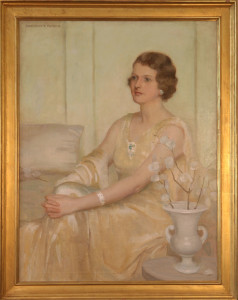
Marguerite Pearson
(1898-1978)
When any person excels in their chosen career, that warrants praise, but when they overcome extreme hardship as well, that demands great respect. As a teenager, Marguerite Pearson contracted polio and was wheelchair-bound the remainder of her life. Despite increasing paralysis, she became a beloved artist, teacher, juror, and—above all—achieved independence, relying on no one for her support. She studied at the Boston Museum School and worked from the Fenway Studio. The Boston Globe art critic A. J. Philpot wrote about her work in a 1924 exhibition: “these are the works of a rare genius—of one who already ranks high and is destined to achieve unusual distinction in the art world.” Pearson began summering in Rockport in 1920 and moved there permanently in 1942. Two subjects dominated her oeuvre: floral still lifes and interior scenes with elegantly dressed ladies in long fashionable attire often reading, playing musical instruments, or conversing with friends. In 1985, I discovered a little figural piece in a locally- made “Frenchy Hillard” frame at a nearby antique shop in Essex, Massachusetts. I liked the scale of the piece and felt it was a perfect small example of her work. I was particularly delighted that it had the well-known “stairway to nowhere” in the painting. Pearson had a false stairway built in her home as a prop for her paintings. Then, unbelievably, about fifteen years later, while visiting Cape Ann dealer David Hall, I discovered a much larger identical image, right down to the flowers on the harpsichord. A wonderful side-by-side comparison, I thought. I believe that the smaller example was not a study, but a completed painting that she liked well enough to repeat in a larger format. This may happen among artists with some frequency, but how often are the pieces ever reunited seventy-five years or so later? Lastly, a really lush, large-size floral still life appeared at the 2003 annual Rockport Art Association fundraising auction. I was really impressed by the painting, which I’m sure was privately owned and had never been cleaned, but underneath all that surface grime was a classic Boston School floral—a beautiful and ambitious work. Marguerite Pearson was truly a painter who happened to be a paraplegic, not the other way around.